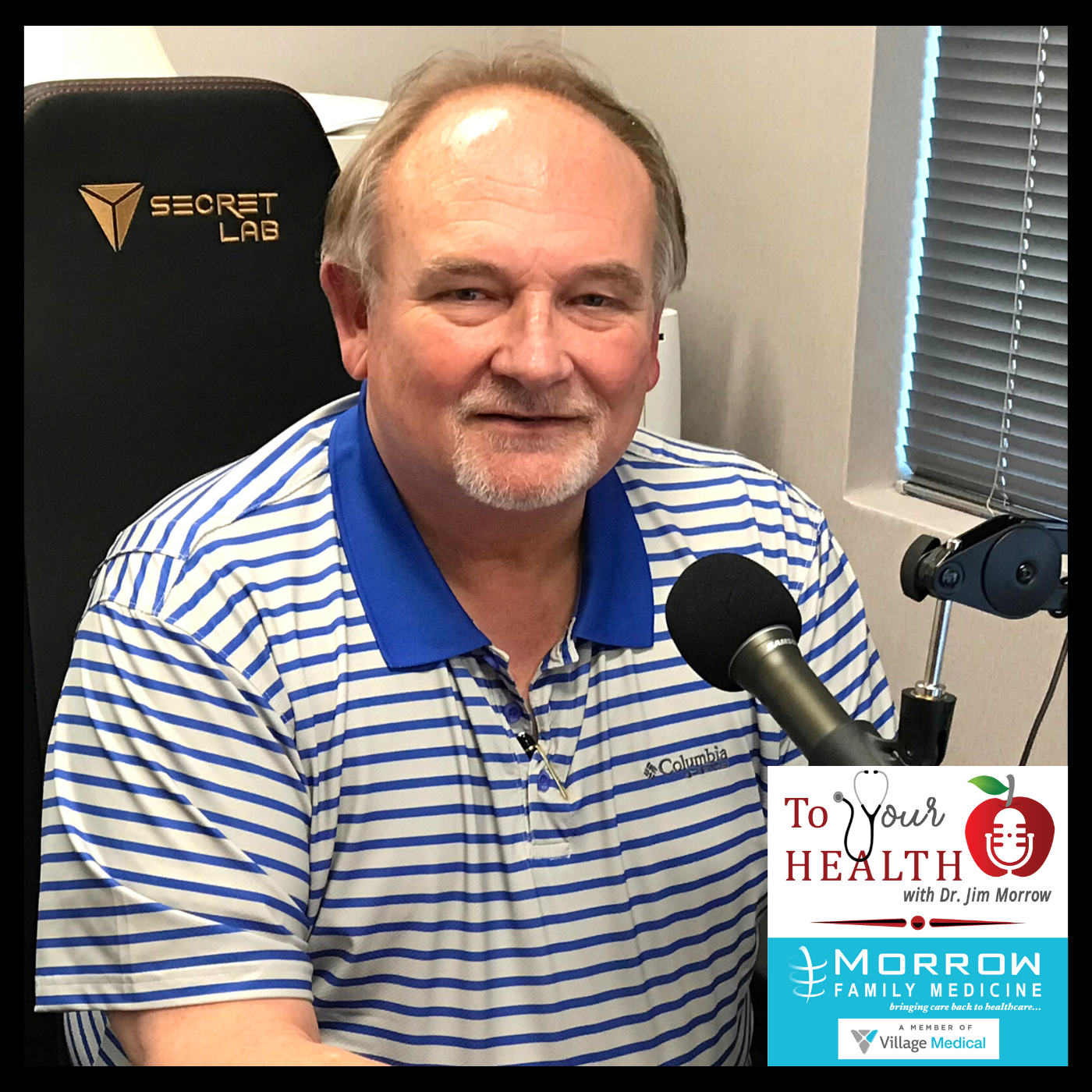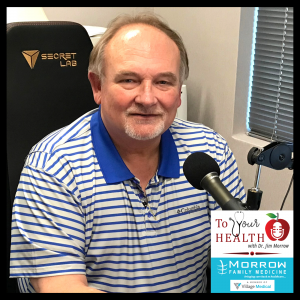
Fitness Trackers and Exercise (Episode 74, To Your Health with Dr. Jim Morrow)
On this episode of To Your Health, Dr. Jim Morrow covered the benefits of fitness trackers and wearables to track your heart rate, to improve your chances of exercising, and track your diet. He gave a formula for determining your ideal heart rate during exercise, the best kinds of activity and fitness trackers, and much more.
To Your Health is brought to you by Village Medical (formerly Morrow Family Medicine), which brings the care back to healthcare.
About Village Medical (formerly Morrow Family Medicine)
Village Medical, formerly Morrow Family Medicine, is an award-winning, state-of-the-art family practice with offices in Cumming and Milton, Georgia. The practice combines healthcare information technology with old-fashioned care to provide the type of care that many are in search of today. Two physicians, three physician assistants and two nurse practitioners are supported by a knowledgeable and friendly staff to make your visit to Village Medical one that will remind you of the way healthcare should be. At Village Medical, we like to say we are “bringing the care back to healthcare!” The practice has been named the “Best of Forsyth” in Family Medicine in all five years of the award, is a three-time consecutive winner of the “Best of North Atlanta” by readers of Appen Media, and the 2019 winner of “Best of Life” in North Fulton County.
Village Medical offers a comprehensive suite of primary care services including preventative care, treatment for illness and injury, and management of chronic conditions such as diabetes, congestive heart failure, chronic obstructive pulmonary disease (COPD) and kidney disease. Atlanta-area patients can learn more about the practice here.
Dr. Jim Morrow, Village Medical, and Host of To Your Health with Dr. Jim Morrow
 Dr. Jim Morrow is the founder of Morrow Family Medicine. He has been a trailblazer and evangelist in healthcare information technology, was named Physician IT Leader of the Year by HIMSS, a HIMSS Davies Award Winner, the Cumming-Forsyth Chamber of Commerce Steve Bloom Award Winner as Entrepreneur of the Year and he received a Phoenix Award as Community Leader of the Year from the Metro Atlanta Chamber of Commerce. He is married to Peggie Morrow and together they founded the Forsyth BYOT Benefit, a charity in Forsyth County to support students in need of technology and devices. They have two Goldendoodles, a gaggle of grandchildren and enjoy life on and around Lake Lanier.
Dr. Jim Morrow is the founder of Morrow Family Medicine. He has been a trailblazer and evangelist in healthcare information technology, was named Physician IT Leader of the Year by HIMSS, a HIMSS Davies Award Winner, the Cumming-Forsyth Chamber of Commerce Steve Bloom Award Winner as Entrepreneur of the Year and he received a Phoenix Award as Community Leader of the Year from the Metro Atlanta Chamber of Commerce. He is married to Peggie Morrow and together they founded the Forsyth BYOT Benefit, a charity in Forsyth County to support students in need of technology and devices. They have two Goldendoodles, a gaggle of grandchildren and enjoy life on and around Lake Lanier.
The complete show archive of To Your Health with Dr. Jim Morrow addresses a wide range of health and wellness topics.
Dr. Morrow’s Show Notes
Tracking Your Fitness
Exercise
- The frequency of cardiorespiratory training is limited more often by patient compliance than by physiology.
- It is not inappropriate for one to exercise daily, but few people do.
- The ACSM recommends a duration of 20–60 minutes of continuous or intermittent exercise
- and a frequency of 3–5 days per week for cardiorespiratory fitness and body composition enhancement.
- Intermittent exercise is described as a minimum of 10-minute bouts accumulated throughout the day.
- The recommended intensity is 65%–90% of maximum heart rate in healthy adults
- and 55%–65% in very unfit individuals.
- The challenge, of course, is to know one’s maximum heart rate.
- Usual equations for HRmaxis 220—age in years
- Healthy adults should maintain a subjective rating of perceived exertion (RPE) of “moderate” to “heavy” or about 13–15 on the scale.
- Beginners can improve compliance by limiting intensity to “light” to “moderate” (RPE 11–13).
- It is not uncommon for athletes to reach “very, very heavy” (RPE 19–20) for short bursts, particularly during interval training such as wind sprints, but there is little reason to recommend these levels for patients.
Wearable Technology: Activity Trackers and Smart Watches
- There is a variety of wearable technologies available in the market that monitor energy expenditure and heart health.
- Physical activity trackers help measure personal metrics involved in fitness,
- such as the number of steps walked, heart rate, quality of sleep, etc.
- They come predominantly in the form of wristbands and smartwatches.
- Wristbands are the most popular brand of activity trackers
- Other wearable technologies include chest, patches, strips, and shirts (e.g., Zephry Shirt).
- Activity trackers typically sync to smart devices and/or upload to computers using wireless connectivity.
- The companion apps, depending on the product, also enable the users to record and track things like food consumption, activities, weight, ECG, heart rate, and temperature;
- and can share the data with trainers and medical professionals.
- Researchers have demonstrated that the data from a wearable device and its companion smartphone app can be integrated into electronic health record systems
- While wearable devices do require certain degrees of user inputs for accurate tracking,
- research seems to indicate that they may be suitable as physical activity monitoring platforms
- and are reasonably accurate for estimating heart rate, number of steps, distance, and sleep duration
- Wristbands have also been shown to be an accurate, reliable, and efficient tool for physicians to track the adoption and maintenance of physical activity programs
- However, there is some skepticism regarding their benefits for monitoring physical activity and other
- Research also shows that the heart rate monitoring function is more accurate at rest than during moderately active exercise
- and may not be suitable in helping clinicians advise their patients about health issues
- Manufacturers are in a race to make medical-grade monitoring available with wearable devices.
- A recent partnership between Fitbit and Dexcom is promising to bring continuous glucose monitoring (CGM) by integrating the popular Dexcom G5 sensor to the Fitbit Ionic.
- Medical equipment manufacturers like Omron are poised to enter the market with their smartwatch that can provide medical-grade blood pressure measurements and sleep tracking.
- There are also products on the horizon (e.g., Cronovo smartwatch) that can provide accurate heart rate functions
- along with prescribing fitness regimens based on individual physical characteristics
- and guiding the user through video tutorials, calorie, and dietary intake tracking, and integrating these functionalities with voice-based recipes
- Given the risk factors associated with CVD, there are a lot of applications and technology aimed at generic health factors such as diet and exercise that decrease users’ CVD risk despite not being explicitly marketed for this purpose.
- Activity trackers have huge user bases (recent filings indicate there are approximately 19 million registered users with over 9 million “active” users,
- and research indicates that usage of wearable devices such as these does show an increase in physical activity
- Similarly, diet trackers and calorie counters such as MyFitnessPal™ also show efficacy when used on a regular basis,
- with research suggesting users of this technology were able to maintain dietary changes better than those who did not use them
- Similar generic applications are also available for blood pressure, smoking cessation, and other associated risk factors.
- For CVD-specific mobile health applications or devices, the first priority for management needs to be personal risk awareness.
- While social media is a good medium for improving general awareness, mobile health needs to be more personalized, where the user gains an awareness of his/her own risk factors and identifies what he/she needs to be doing in order to minimize his/her chances of suffering from the relevant condition
- In addition to personal awareness, ideally, the application or device should provide users with information on what they can do to minimize or mitigate any identified risks.
- This is a potentially complicated issue to address,
- as ideally the aim should be to not only provide users with as much relevant information as possible,
- but also to prompt them to seek advice from their health professional when warranted.
- Lastly, these applications should have a monitoring component so users can see if they are making progress,
- and track whether any changes in health behavior lead to changes in the risk of having an adverse event
- Research also shows that the heart rate monitoring function is more accurate at rest than during moderately active exercise
- The companion apps, depending on the product, also enable the users to record and track things like food consumption, activities, weight, ECG, heart rate, and temperature;
- Physical activity trackers help measure personal metrics involved in fitness,
Electronic Activity Monitors
- Pedometers continue to be useful tools to monitor physical activity,
- but are dinosaurs compared to the wearable electronic activity monitoring devices that have been developed in recent years.
- These sophisticated fitness trackers can be
- worn on the wrist,
- clipped to clothing,
- or incorporated into smartphones.
- Most utilize an accelerometer to monitor movement, even during sleep,
- and some versions add GPS technology.
- Optical sensors for heart rate are common and provide useful data to optimize exercise intensity.
- Virtually all monitors sync with smartphones or personal computers for tracking and graphic display of physical activity, calorie expenditure, and more.
- Publications like PC Magazine publish online annual reviews of these tools and can provide comparative data for the latest models.
- It is worth noting that not all activity monitors are water-resistant.
- Like most consumer electronics, function increases, and cost decreases almost exponentially each year, so there are devices for patients in all economic groups.
Three Types of Fitness Trackers
- There are 3 basic types of fitness trackers:
- Basic fitness trackers
- Count the approximate number of steps you take and calculate the distance you’ve traveled using that data.
- These are best for walkers and runners who want to track distance-based activity.
- Heart rate monitoring trackers
- Do everything a basic fitness tracker can, but they also have sensors that can monitor changes in your heart rate.
- These can help you determine the number of calories you’ve burned throughout the day
- Heart rate monitoring trackers with GPS
- Can do all of the above, plus communicate with satellites to triangulate your position anywhere on the globe (provided you’re not inside).
- This is a great option if you’re a cyclist or like to hit the trails.
- Basic fitness trackers
The 3 Best Fitness Trackers
Garmin Vivofit 3 – Best Fitness Tracker Under $100
Fitbit Charge 2 – Best Heart Rate Monitoring Fitness Tracker
Garmin Vivosmart HR+ – Best Heart Rate Monitoring and GPS Fitness Tracker















